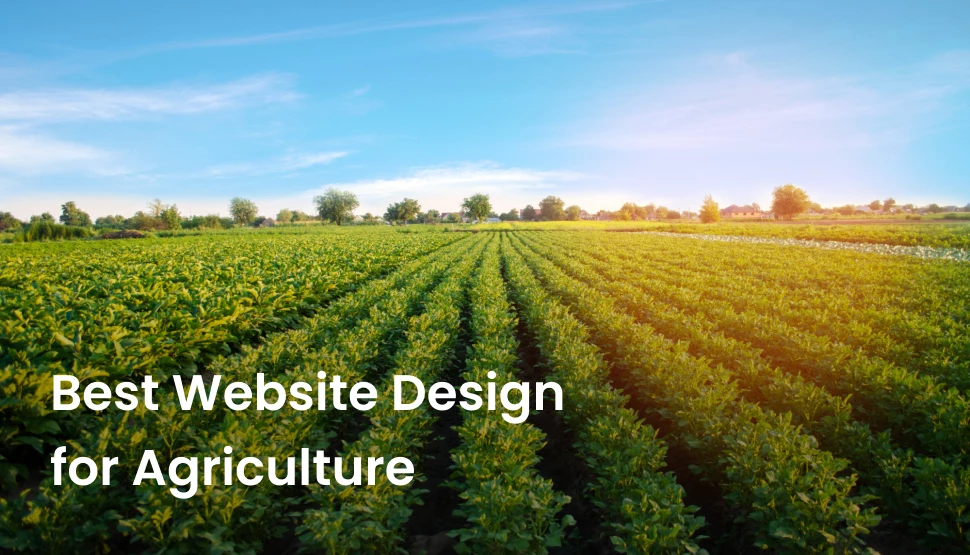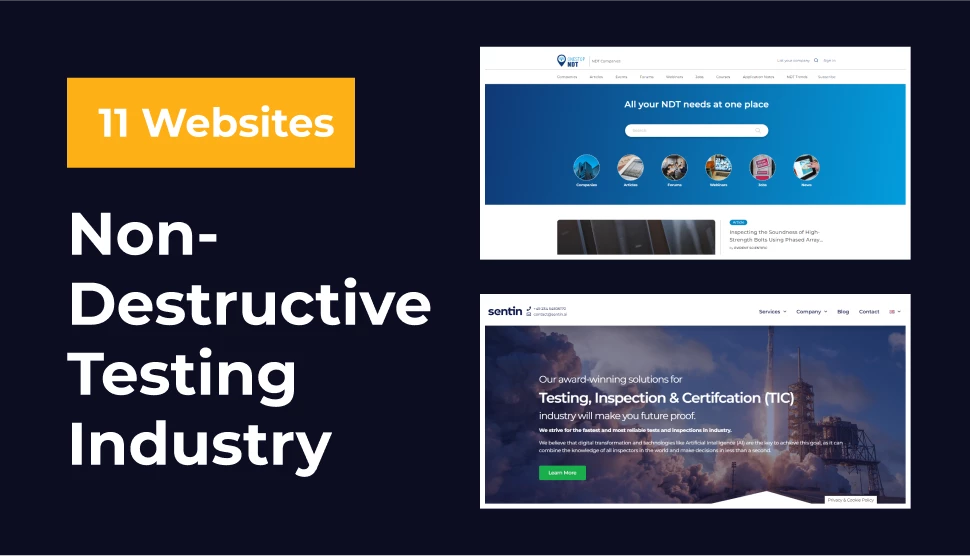Harvesting Progress: Best Website Design for Agriculture
6 mins | Nov 24, 2023

In agriculture's vast and dynamic landscape, where the rustle of leaves and the scent of freshly turned soil have long been the heartbeat of livelihoods, a new rhythm is emerging—one composed of clicks, scrolls, and digital dialogues. In this age of technological tilling, the role of a well-crafted online presence cannot be ignored. Farmers, agri-entrepreneurs, and enthusiasts are turning to the web for market updates and to build a virtual barn of shared knowledge. This isn’t just about websites; it's about sowing the seeds of connection in the vast online fields of agriculture.
Educational Platforms: Growing Knowledge Like Crops
In the sprawling fields of the internet, educational platforms like AgriLife Extension and FarmProgress act as rich soil for cultivating knowledge. These websites aren't just pages on a screen; they're dynamic resources bursting with articles, tutorials, and research papers. Farmers dig into this digital soil to discover the latest insights on crop management, livestock care, and sustainable farming practices, empowering them to make decisions that bloom into successful harvests.
Marketplace and Trading Platforms: A Digital Farmers' Market
Imagine an online marketplace buzzing with activity, where farmers showcase their produce and buyers browse through digital stalls. Platforms like AgMarketNet and AgriExchange are today's digital farmers' markets, connecting sellers with buyers, facilitating transactions, and providing real-time market information. It's not just commerce; it's a vibrant community where the spirit of agriculture thrives in every transaction.
Weather and Crop Monitoring: Navigating the Elements
Weather conditions can make or break a harvest. Enter websites like Weather.com and AgWeatherNet, serving as the navigators through the unpredictable skies. These platforms provide real-time weather forecasts, helping farmers plan their activities and steer clear of stormy setbacks. When it comes to crop health, websites like EOS Crop Monitoring soar above fields, using satellite imagery and data analytics to spot issues before they take root.
Precision Farming Tools: Cultivating with Digital Precision
In the digital fields, precision farming tools from websites like PrecisionAg and Trimble Agriculture are the modern ploughs and tractors. GPS-guided tractors traverse fields with pinpoint accuracy while drones soar overhead, monitoring crops like digital scarecrows. Farmers aren't just sowing seeds; they're orchestrating a symphony of technology to maximize yields while harmonizing with the land.
Government & Agricultural Organizations: Growing Support Networks
Amidst the digital harvest, government and non-profit organizations cultivate support. The USDA website is a treasure trove of resources, from grants to regulatory guidelines. Organizations like the Food and Agriculture Organization (FAO) of the United Nations join the digital fray, offering global insights and initiatives for sustainable agriculture. It's not just bureaucracy; it's a network of support for the stewards of the land.
Community and Networking Platforms: Digital Barn-Raising
Platforms like AgTalk and FarmChat are gathering places for farmers. It's not just forums; it's a virtual barn raising, where farmers share stories, seek advice, and build a sense of community. In the vast expanse of the internet, these platforms become the watering holes where friendships sprout, and the collective wisdom of the land is passed down through digital generations.
E-commerce Platforms for Agricultural Supplies: The Digital General Store
Picture a bustling digital general store stocked with seeds, fertilizers, and farm equipment. E-commerce platforms like AgriSupply and FarmSolutions bring the convenience of online shopping to agriculture. It's not just transactions; it's a virtual journey through aisles of essential supplies, where farmers browse, compare, and select the tools that will shape their harvests.
AgTech Startups and Innovation Hubs: Seeds of Digital Revolution
AgFunder and AgTech Finder are the nurseries of innovation on the fertile grounds of the internet. These websites showcase the latest gadgets and gizmos, from smart irrigation systems to data-driven analytics. It's not just technology; it's the seeds of a digital revolution taking root in the agricultural landscape.
Here are 3 Website designs of Agriculture you must see:
1. Ministry of Agriculture and Farmers' Welfare, India :
The website belongs to the Ministry of Agriculture and Farmers' Welfare in India aiming to provide comprehensive information and resources related to agriculture and allied sectors. As of my last knowledge update in January 2022, the website serves as a vital hub for farmers, policymakers, and stakeholders in the agricultural domain.
- Content and Sections:
The website likely contains sections dedicated to agricultural policies, schemes, and programs initiated by the government. Information on crop patterns, market trends, and weather forecasts may also be available. Additionally, the site might provide updates on research and technological advancements in the agricultural sector.
- User-Friendly Interface:
The website should have a user-friendly interface to cater to a diverse audience, making it easy for farmers and other users to navigate. This could involve clear categorization of information, relevant links, and multimedia content for better understanding.
- News and Updates:
Regularly updated news and announcements related to agriculture, farming, and rural development may be featured. This keeps visitors informed about the latest developments and government initiatives.
- Language:
Content is available in multiple languages to cater to the linguistic diversity in India.
2. Beck Ag :
- Overview:
Beck Ag is a company specializing in providing innovative solutions and services to the agricultural industry. The website serves as a platform to showcase their offerings and connect with farmers and stakeholders in the agribusiness sector.
- Services and Solutions:
The website may have sections detailing the various services and solutions offered by Beck Ag. This could include precision farming technologies, data analytics, and other tools aimed at improving efficiency and productivity in agriculture.
- Client Success Stories:
Testimonials or success stories from clients might be featured to demonstrate the impact of Beck Ag's services. This can build trust and credibility among potential clients.
- Blog/Resource Section:
A blog or resource section is common on such websites, providing valuable insights, industry trends, and tips for farmers and agribusiness professionals.
- Contact Information:
Clear contact information, including phone numbers and possibly a contact form, is crucial for potential clients and partners to get in touch.
3. UPL Limited :
- Company Overview:
UPL Limited is a global agribusiness company, and its website serves as a comprehensive platform for showcasing its products, innovations, and contributions to sustainable agriculture.
- Product Portfolio:
The website likely features detailed information about UPL's diverse product portfolio, including agrochemicals, seeds, and crop protection solutions. Each product category may be elaborated upon, emphasizing its features and benefits.
- Sustainability Initiatives:
Given the increasing focus on sustainable agriculture, the website might highlight UPL's sustainability initiatives, detailing how the company is contributing to environmental conservation and responsible agricultural practices.
- Investor Relations:
For stakeholders and investors, there may be a dedicated section providing financial reports, investor presentations, and other relevant information.
- News and Events:
Regular updates on company news, events, and participation in industry conferences or exhibitions may be present to keep stakeholders informed.
- Global Presence:
Information about UPL's global presence, partnerships, and collaborations could be highlighted, showcasing the company's reach and influence in the agricultural sector worldwide.
Remember, the details provided are based on the general expectations for websites in these sectors. For the most accurate and up-to-date information, it's advisable to visit the respective websites directly.
Conclusion:
As the agricultural industry embraces the digital revolution, the significance of an optimized website design cannot be overstated. Agricultural businesses can cultivate a robust online presence by embracing user-centric interfaces, mobile responsiveness, and content that resonates with stakeholders. The synergy between technology and agriculture through an intelligently designed website fosters connections promotes innovations, and facilitates the exchange of knowledge within the industry. Harnessing the power of cutting-edge design principles tailored for agriculture will yield growth and nurture sustainability in this ever-evolving field. Embrace the potential of a thoughtfully designed website and reap the fruits of progress in the dynamic landscape of agriculture.
Author








